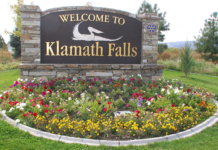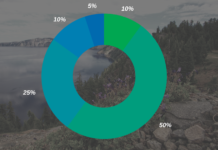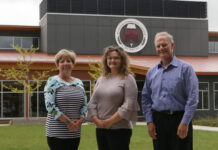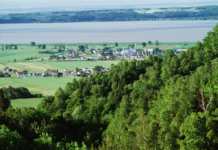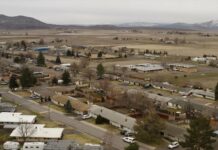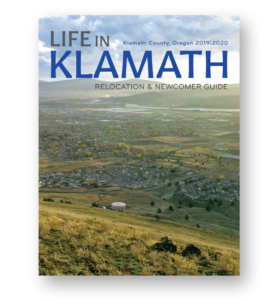Working to Make Healthy Choices Easier:
A conversation with Paul Stewart

Paul Stewart has served as President and CEO of Sky Lakes Medical Center since 1992, and was director of the hospital’s clinical services for six years prior to that. He has received numerous awards for his work within the medical community and health care industry, being selected by Becker’s Hospital Review as one of “300 Hospital and Health System Leaders to Know” (2013) and as one of Becker’s “50 Rural Hospital CEO’s to Know” (2015). In 2017 he was selected recipient of the Statesman of the Year Award from Oregon Business & Industry. He also is a former chair of the Oregon Association of Hospitals and Health Systems, and serves on the Oregon Institute of Technology Board of Trustees.
Sky Lakes Medical Center under the direction of President and Chief Executive Officer Paul Stewart is recognized as a leader in the health care industry as well as being a good corporate citizen and community partner. Sky Lakes is the largest employer in the region with more than 1,500 employees and an annual payroll of nearly $120 million.
Sky Lakes over the past decade has been pivotal in local initiatives aimed at improving health. That seems an odd thing for a hospital to do. Why would you put such emphasis on those programs?
It does seem counter-intuitive that a business that’s paid primarily to take care of people who are suffering from illness, injury, or disability would be so willing to invest in initiatives and programs designed to keep people out of the hospital. Our corporate values call on us to demonstrate good health, to be an intellectual and social asset to our community, and to engage others to help prepare for our collective future. Some of the ways we do this is by encouraging innovation and creativity in community-wide health and wellness programs, and by demonstrating our commitment to the needs of the people we serve. It is our mission to help create a healthier community.
The community programs didn’t just happen. Where did you start?
As with many other programs launched within the Sky Lakes corporate family, we started with data and reliable information. For instance, data tells us that heart disease, lung diseases and diabetes are among the leading causes of death in the United States; we have no reason to think Klamath Falls is any different. Further, data confirms that lifestyle choices are the principal drivers of those diseases. The so-called “Four Horsemen of Poor Health” – lack of physical exercise, poor diet choices, tobacco use, and drinking alcohol to excess – are the biggest culprits and affect other aspects of health. The programs Sky Lakes helped create are aimed at flipping those. We want to encourage people to be more physically active and have better nutrition, to not smoke, and, if they drink, to do so in moderation. They need to be done in a positive and supportive environment that encourages long-term success.
Sky Lakes backs these initiatives even though there’s no tangible return on the investments?
That’s correct. Currently, health care providers in the United States are paid to fix health problems – think of it as “sick care” – instead of helping people avoid those problems in the first place, which would be true “health care.” We believe it is our responsibility – indeed, our moral obligation – to help keep people well by putting more emphasis on prevention; by teaching and coaching and making healthy choices easier. It’s also a better value for the community and the health care system in general to invest in ways to stop poor health rather than dealing with its very expensive consequences later. It comes down to personal responsibility and then building the structures to support the positive better choices. That’s why we help schools build tennis courts, and local organizations build and maintain hiking trails and protected bike lanes, and support ways to improve access to fresh produce and demonstrations to incorporate the produce in daily diets. Our investments also rejuvenated Kit Carson Park to encourage children to play outdoors, and Klamath Commons park downtown for families to enjoy.
Sky Lakes was an early adopter of the Blue Zones Project’s principals. Where did that begin?
A decade or so ago, Sky Lakes and a handful of community partners launched what we called the Better Health Partnership, a small-scale test to try to encourage healthier behaviors and identify barriers people might encounter to make changes. Data indicated the test worked, so we scaled it up to what became the Healthy Klamath initiative. This is an informal coalition of key members of the local health care community as well as government leaders, schools, the media, and others who worked on the problems associated with poor health in their own ways. Now fast-forward a few years to the Oregon Healthiest State competition in Portland. Members of the Healthy Klamath coalition and others from Klamath Falls (including several from Sky Lakes), using lessons from the Better Health Partnership and armed with the desire to improve the health of their community, presented an excellent case that resulted in Klamath Falls being named the first Blue Zones Project community in the Pacific Northwest. Sky Lakes provided $600,000 in matching funds over three years to leverage $1.2 million from Cambia Health Foundation for the project. At roughly the same time, we launched the Sky Lakes Wellness Center to help reduce risk factors for a managed population in anticipation of expanding the scope to the larger community. Concurrently, Sky Lakes was instrumental in the creation of the Klamath Works program aimed at providing skills that would lead to more employment within the population. Research shows that there’s a correlation of employment and improved social status and better health. The totality of our work is ambitious, but necessary.
What does the Blue Zones Project mean to the region?
Among other things, the Blue Zones Project validated many of the community’s other efforts in a nationally recognized way. It also helped focus our efforts by adding full-time staff to organize and prioritize programs. Remember the earlier efforts were all done by volunteers working on their part of the problem while also holding down full-time jobs. The cohesiveness and collaboration of the coalition and the partnership before that, and the common goal of an improved Klamath community, have not gone unnoticed: The Robert Wood Johnson Foundation awarded Klamath County the 2018 Culture of Health Prize, one of four in the nation. There were 200 other communities in the competition. That’s very satisfying independent recognition of the collaboration.
With those successes, what’s next?
The community has made excellent progress and continues to make huge strides, but the work is far from over. This is a journey; we won’t wake up one morning and say, “Here we are. We’re healthy.” Success requires sustained and purposeful effort. That’s why Sky Lakes is the principal backer of “Blue Zones 2.0,” which is the evolution of the initial project and aimed at building on the first three years, expanding where it makes sense to do so, and innovating when we can. Sky Lakes also continues to help community partners expand opportunities for physical activity, improve access to fresh fruit and vegetables, and we host smoking cessation classes while making Wellness Center programs more available.
Access to care is also important to the health of the community. What is Sky Lakes doing to expand access?
The Sky Lakes Collaborative Health Center building on the medical center campus is the most visible example of those efforts. This is not to minimize in any way our extensive and ongoing work to recruit and retain providers, and will even complement those efforts. The top two floors of the $50 million building consolidate five Sky Lakes primary care clinics scattered around the city. Not only is that better for patients – we will be able to offer services unavailable to smaller stand-alone clinics – but it also provides additional capacity for new providers so they can move in and start to work right away. The building also expands Cascades East Family Medicine Clinic making it more attractive to resident physician candidates and, again, adding capacity for patients. Also, Oregon Health & Science University’s Campus for Rural Health will occupy space on the ground level. That means more students in a variety of medical disciplines can come to Klamath Falls to learn and train, and, potentially practice after they graduate.
How is that?
Data and our experience with Cascades East residents show that providers are likely to practice in or very near the community where they received their training. More than three-fourths of Cascades East graduates over the program’s 25-year history still practice in a rural community, and nearly two-thirds of the graduates in the past eight years have remained in Klamath Falls. We’ll capitalize on that with the Collaborative Health Center and we believe it will become a magnet for other commerce further boosting the local economy. These are exciting times for health care and for Klamath Falls: innovative and effective new programs will change our community. It’s an adventure, and we’re honored to be part of it



